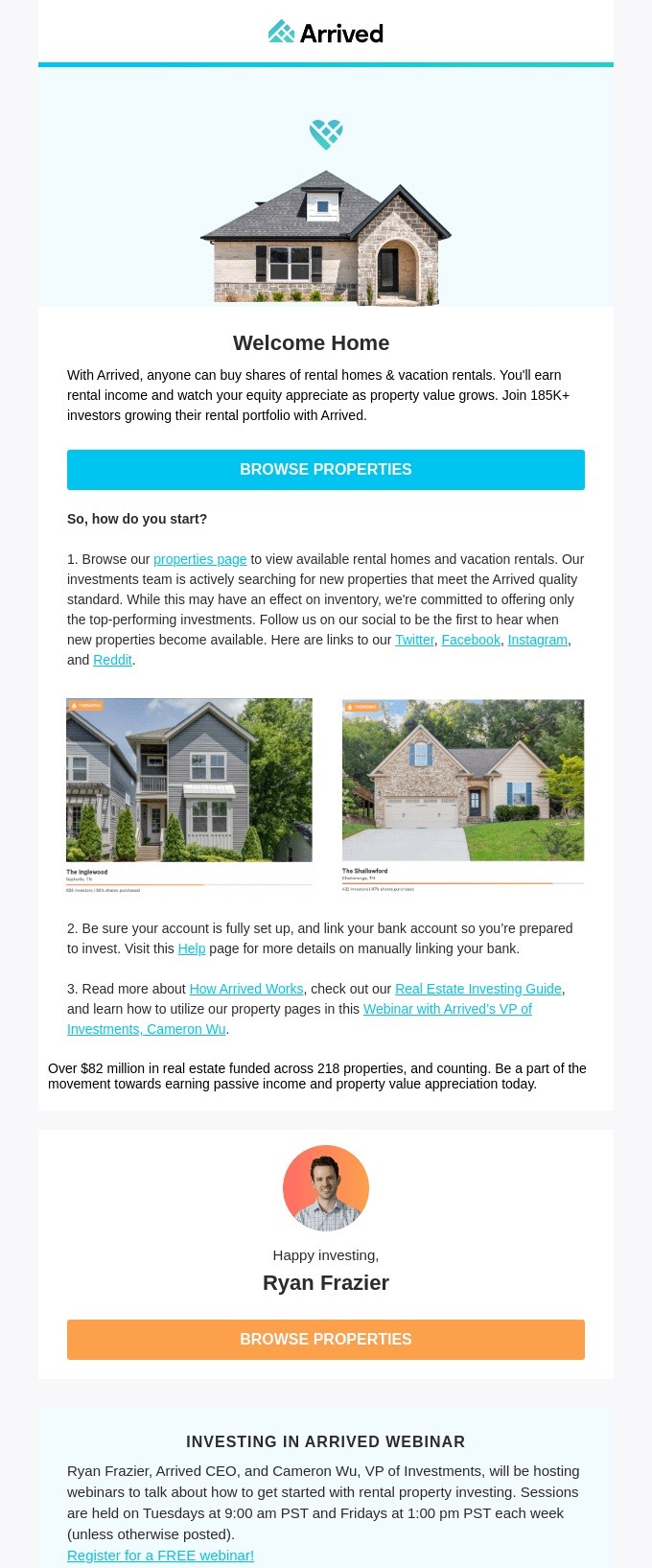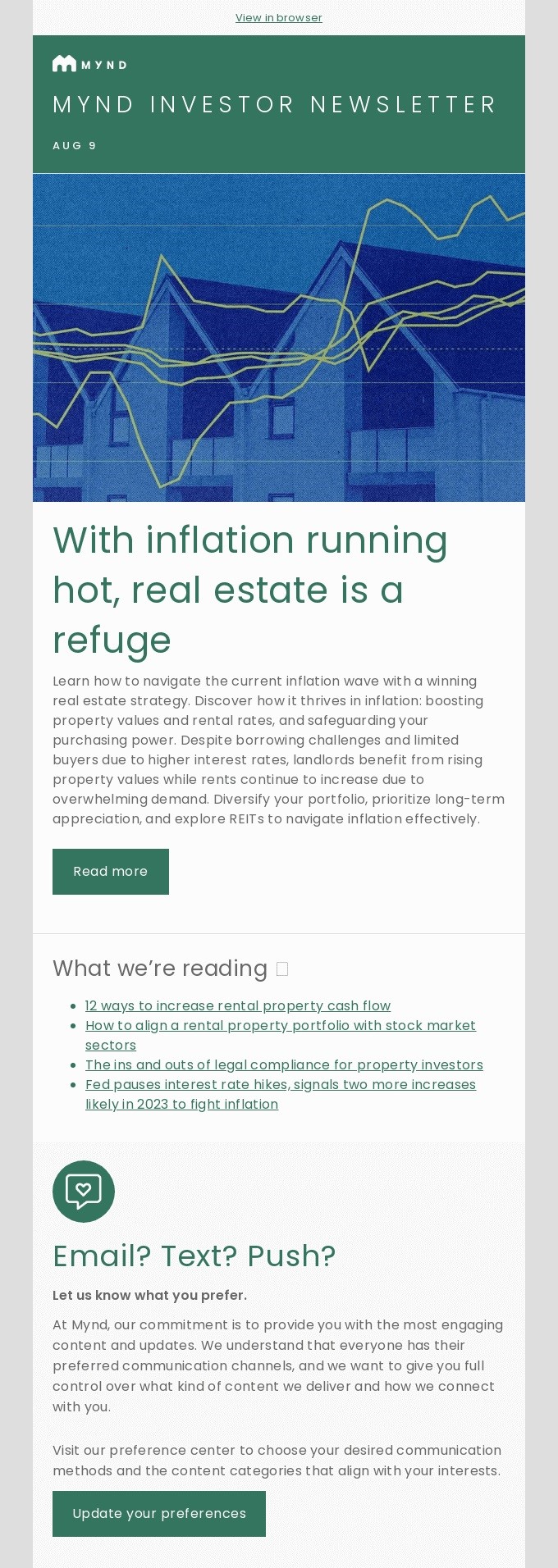The real estate industry is dynamic, and competition is fierce. Consumers must sift through hundreds of listings to find their dream property.
Meanwhile, real estate professionals may struggle to stand out in a crowded market. Relying solely on traditional advertising techniques can make it challenging to reach your target market and convert leads.
That’s where real estate email marketing comes in as a differentiator. Email marketing is a powerful tool for realtors, with a 40% higher conversion rate. It allows targeted messaging and personalized communication to engage potential clients.
That said, crafting engaging email campaigns and reaping high ROI is not easy. If you’re unsure where to start, this guide is for you.
In this article, we’ll cover everything about creating an effective real estate email campaign, including practical tips to boost your realtor email marketing efforts.
Why does email marketing matter for real estate?
Email marketing can be a powerful tool for nurturing relationships with clients. It helps manage the lengthy real estate sales cycle. Here are some of the advantages of email marketing for real estate professionals:
- Value for money: Email marketing can yield a high return on investment in the real estate industry, going as high as 4200%. It’s a great investment for businesses that want to maximize their marketing budget.
- Direct engagement with clients: Email marketing allows businesses to communicate with potential clients directly.
Potential clients can ask questions, request specific listings, or schedule appointments through email. This can create a more interactive conversation throughout the sales process.
- Personalization: By analyzing customer data, you can personalize your messages to each customer and craft emails that resonate with each recipient.
This personalized approach can make customers more receptive to your marketing messages, thereby increasing engagement.
- Efficacy with automation: Consistency is the key to building customer trust. Real estate agencies can establish seamless communication by automating their email marketing campaigns. Targeted promotions and information can be delivered to the right audience based on specific triggers, enhancing efficacy and boosting conversion.
Common challenges and how to overcome them
Although real estate email marketing offers several benefits, it also comes with challenges. Here are some common challenges in email marketing for realtors and how to approach them:
- Maintaining high engagement rates: Keeping subscribers engaged with your emails can be challenging.
To address this, you can segment your email list based on subscribers’ preferences, behavior, and stage in the buying or selling process.
By grouping recipients, you can send personalized and timely emails that match their needs and expectations.
Additionally, ensure your content is fresh and varied and provides value to your subscribers.
- Managing a diverse subscriber list: Real estate businesses often deal with a diverse subscriber list. This can include potential homebuyers, sellers, renters, investors, and other industry stakeholders.
It can be challenging to cater to each subscriber’s unique needs and preferences. Again, segmentation and automation are the main tools for overcoming this challenge.
- Ensuring emails reach their intended recipient: Issues like spam filters or invalid email addresses may cause your emails to miss their intended recipient.
To improve email deliverability, ensure you maintain a clean email list. Check and remove inactive subscribers or invalid email addresses. You can also use reputable email service providers (ESPs) for their robust deliverability features.
Also, avoid overusing spam trigger words like ‘free’ and ‘urgent’. Focus on creating clear, concise, and informative subject lines and email content.
Lastly, you can implement authentication measures on your domain to establish your email address as a legitimate sender.
- Maintaining content relevance and value: The real estate market is dynamic. Prices can fluctuate, new listings appear daily, and buyer interests can shift. Keeping your email content fresh and relevant to your audience can be challenging.
To overcome this challenge, you must stay on top of market trends and local events. This will help you devise real estate email marketing ideas to keep your content relevant.
Always provide informative content that positions you as a trusted advisor. For example, you could create guides, reports, industry news, or case studies of real estate transactions.
Building a robust email list for real estate marketing
A thriving email list is important for email marketing real estate success. You need engaged subscribers who open and interact with your emails.
Here, we’ll examine the best practices for maintaining email list health and engagement.
Strategies for list growth in real estate
Here are some effective methods for building your real estate email marketing list:
- Open houses: Hosting open houses is a popular way to grow your email list in the real estate industry. You can invite potential buyers and investors to view a property in person.
This will allow you to collect contact information from attendees. Additionally, you can follow up with these leads after the open house to nurture relationships.
- Digital content offers: You can develop informative resources like e-books, guides, or market reports. These resources can address common questions or concerns that homebuyers or sellers may have.
Ask visitors to provide their contact information in exchange for the resource. You can do this via a lead capture form on your website or social media channels.
- Website opt-in forms: Place strategic opt-in forms throughout your website to capture leads.
This can be on landing pages and blog posts. Communicate the benefits of subscribing to your newsletter, such as exclusive listings or insider tips.
Maintaining list health and engagement
Expanding your email list and maintaining good engagement levels is important. Here are key practices for maintaining a healthy email list:
- Regular list cleaning: Regularly check and remove inactive subscribers. This can improve open, click, and deliverability rates and keep your list relevant.
- Engagement tracking: Track key metrics like open rates and click rates. Analyze what resonates with your audience and adjust your strategy.
- Segmentation and personalization: This involves dividing an email list into more targeted groups.
You then deliver personalized content tailored to each group’s interests and preferences. This increases the relevance of your emails, thereby increasing engagement.
- Consistency in email delivery: Maintain regular communication with your subscribers. Don’t bombard them with emails; instead, establish a predictable email schedule to keep your brand top-of-mind.
Real estate email campaigns that drive success
A well-crafted email campaign can drive engagement and close deals. Crafting compelling real estate emails requires a strategic approach. Here are some real estate email marketing ideas you can invest in to drive success.
Welcome sequences
Your welcome emails set the tone for your relationship with your subscribers. That’s why it’s important to set a good first impression.
Here’s how you can design your real estate welcome sequences:
- Introduce your brand: Introduce your agency’s mission, values, and what sets you apart from the competition.
- Set expectations: Outline what clients can expect from your email communications. This can be regular updates on market trends or exclusive property listings. Also, let them know how often and when they can expect emails from you.
- Add a CTA: Use a clear CTA to get recipients to explore your services.
Take a look at this welcome email by Arrived. It provides a quick guide on how to get started. It also provides links to resources that the recipient would find valuable.
 Image via Really Good Emails
Image via Really Good Emails
Property showcase emails
These emails highlight new listings, open houses, and featured properties. They are great for generating interest and driving traffic to listings. Include important details, such as price, location, and links to resources.
Here are some best practices for creating compelling property showcase emails:
- High-quality imagery: Invest in high-quality, professional-looking images. This can help showcase properties in their best light. Beyond this, include clear descriptions to help customers understand a property’s key features.
- Clear CTA: Make it easy for recipients to learn more. Include a clear CTA to prompt recipients to take your desired action.
- Personalization: Tailor property recommendations based on recipients’ preferences and behavior. Personalized recommendations can show attentiveness and enhance customer experience.
Here’s a good example of a property showcase email by Sell Prop Auctions. It showcases its property listing with high-quality images and detailed pricing information.
 Image via Really Good Emails
Image via Really Good Emails
Market insights and educational content
With this email, you can position yourself as a valuable customer resource. You can share insightful content to educate your subscribers, including:
- Industry trends and analysis: These are valuable, up-to-date information about your local market. This could include trends in pricing, inventory levels, or buyer demographics.
- Buying and selling tips: You can offer practical home buying and selling advice. This can include tips on preparing a home for sale, negotiating offers, and managing the closing process.
- Property management best practices: This type of educational content covers a wide range of topics. They include marketing strategies, tenant screening, property inspections, maintenance and repairs, and more.
This email by MYND is a good example of educational real estate email content. It provides valuable information on strategies to thrive in the real estate industry during inflation.
 Image via Really Good Emails
Image via Really Good Emails
Client success stories and testimonials
A powerful way to build credibility with potential clients is through client testimonials. This type of email adds a personal touch to humanize your brand and showcase your expertise.
You can include success stories or satisfied client testimonials. You also can even be specific with the challenges your clients faced and how you helped them overcome them. With this, you show your expertise and commitment to your clients.
Leveraging automation for personalization and efficiency
Automation has become an important email marketing process to improve customer experience. Automated tasks ensure consistent messaging and reduce human error.
Here’s how you can use automation to enhance your real estate email marketing:
Implementing automated email flows
Automated email flows are a key component of a successful email marketing strategy. You can set up automated sequences to engage your clients through the sales funnel.
Automated email sequences are pre-written emails triggered by specific client actions or milestones. They allow you to provide timely and consistent email communications.
Here’s how you can introduce automated sequences into your email campaign strategy:
- Identify triggers: Start by defining the email automation triggers. These are specific actions taken by customers that will activate your automated email flow. This could be a website signup, property inquiry, or a completed viewing.
- Set up automated responses: Once you’ve set the triggers, create automated email responses tailored to each of them. For example, a property inquiry might trigger an automated email with more details about the property.
- Schedule your touches: Space out your emails to avoid overwhelming recipients. For example, consider a welcome email upon signup, followed by informative content a few days later, and a final check-in after a week.
Personalizing communications at scale
Automation saves time and ensures consistency in delivering personalized communication.
Here are some real estate email marketing ideas for personalized communication:
- Customer data: Use customer data to tailor your emails to individual recipients. For example, you can send personalized messages based on their interactions with your emails.
- Personalized greetings and recommendations: Start emails with the recipient’s name and carry on with personalized recommendations based on the recipient’s previous searches or preferences.
With marketing automation tools, you can streamline the personalization process at scale. Set up automated email sequences and schedule emails to be sent at optimal times. This way, you can provide relevant information at each stage of the buying process.
Analyzing and optimizing your email strategy
Writing compelling real estate emails is only the first step. You need to analyze and optimize your email strategy to maximize your success.
Key metrics for real estate email marketing
To measure the success of your email campaigns, you must track key performance metrics. Here are some key metrics to keep an eye on:
- Open rates: This metric indicates the percentage of recipients who opened your email. A high open rate suggests that your subject lines are compelling and your emails resonate well with your audience.
- Click rates: This is the percentage of recipients who clicked on a link in your email. It reflects the effectiveness of your content and CTA placement.
- Conversion rates: This is the percentage of recipients who completed a desired action. This shows how well your email content is being received.
- Bounce rates: This represents the emails that weren’t delivered. High bounce rates may reflect issues with your email list quality or deliverability.
- Unsubscribe rates: This depicts the percentage of recipients who opted out of receiving further emails from you. You can assess at which points your subscribers unsubscribe to help you gauge the relevance of your email communications.
Tracking these metrics doesn’t only help you understand the effectiveness of your email campaign. It also helps you identify areas for improvement and work on them.
A/B testing for real estate emails
A/B testing is a popular method of optimizing email marketing campaigns. It allows you to compare two email versions to see which one performs better. You can refine various elements and optimize your emails for higher engagement.
Here’s a guide on conducting A/B tests to refine various elements of your real estate emails:
- Choose an element to test: You can test various elements of your real estate email campaign. This could be the subject line, email content, CTA, visuals, or send time.
- Create variations: Develop two or more versions of the element you want to test. Ensure the rest of the email remains consistent so other factors do not influence the results.
- Segment your audience: Divide your email list into two groups. Send each group a different version of the email.
- Track and analyze results: After the test period, analyze the results to see which version performed better.
- Make data-driven decisions: Based on the results, adopt the version that resonates better. Use the winning elements in your future email campaigns.
A/B testing is an ongoing process. Don’t stop at one test. Keep testing different email elements and optimize your strategy for better impact.
Building trust with potential clients is crucial in any industry. One of the ways to do this is by complying with email marketing laws and ethical marketing practices.
Adhering to email marketing laws
Legal frameworks shape email marketing practices in different countries. These include the US CAN-SPAM Act and the EU’s General Data Protection Regulation (GDPR).
These regulations outline requirements for sending commercial emails. The CAN-SPAM Act mandates the provision of unsubscribe options and sender identification.
GDPR mandates strict regulations about the collection and processing of personal data. It necessitates clear consent from individuals and robust data protection measures.
Opt-in forms provide an opportunity to obtain this consent. Your emails should also include a clear and easy way for recipients to unsubscribe from your mailing list anytime they want.
Following ethical marketing practices
Beyond legal obligations, ethical considerations should guide your real estate email marketing efforts.
Here are a few key principles to consider:
- Transparency: Be upfront about your offerings. Avoid misleading claims and setting unrealistic expectations.
- Respect for client privacy: Treat client data with the utmost care. Ensure your email marketing platform has robust security measures in place. Only use collected data for the intended purpose, as outlined in your privacy policy.
You can build lasting relationships with your subscribers and potential clients by upholding these ethical standards.
Wrap up
Real estate email marketing can be a powerful tool to connect with potential clients. It offers targeted messaging, personalized communication, and direct engagement.
With these benefits, you can build trusting relationships with clients and increase sales. You can also streamline your email marketing efforts through automation for better effectiveness.
Remember, the success of your real estate email marketing campaign lies in providing value to your subscribers. Take advantage of the strategies we outlined above to create effective email campaigns for your real estate business.
